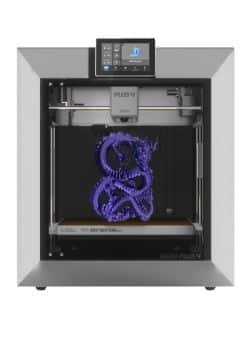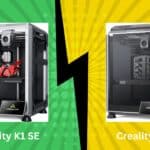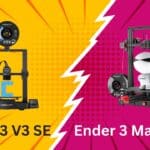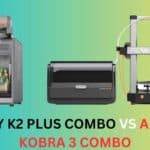
The QIDI PLUS4 wins for me with its high-temperature material support and future multi-color potential, while the QIDI MAX3 suits advanced users with its larger build volume and open-source firmware.
The world of 3D printing is evolving rapidly, and QIDI Technology has established itself as a reliable brand for both beginners and professionals. Two of their standout models, the QIDI PLUS4 and the QIDI MAX3, are often compared due to their impressive features and capabilities. Both printers are designed for high-speed printing, large build volumes, and compatibility with advanced materials, but they cater to slightly different user needs. In this article, we’ll dive deep into the similarities, differences, and unique selling points of these two machines to help you decide which one is the right fit for your 3D printing journey.
Affiliate Disclosure
We participate in Amazon affiliate programs, earning fees from qualifying purchases via links at no extra cost to you. It’s how we keep this blog rolling and my 3D printers buzzing with fresh filament for reviews like this one!
Related: QIDI PLUS4 3D Printer Review: The Ultimate Solution for Fast and Flawless Prints!
Related: QIDI MAX3 3D Printer Review: Speed, Precision, and Versatility!
QIDI PLUS4 vs QIDI MAX3 Review
Both the QIDI PLUS4 and QIDI MAX3 are designed for speed, precision, and versatility. They share core features like 600mm/s high-speed printing, 65℃ chamber heating, and fully automatic bed leveling. However, they cater to slightly different audiences, with the PLUS4 focusing on multi-material compatibility and the MAX3 emphasizing industrial-grade durability and larger build volume.
Let’s break down their features, performance, and usability to see which one comes out on top.
Key Features Comparison
| Feature | QIDI PLUS4 | QIDI MAX3 |
|---|---|---|
| Print Speed | 600mm/s | 600mm/s |
| Build Volume | 12″ x 12″ x 11″ (305 x 305 x 280mm) | 12.8″ x 12.8″ x 12.4″ (325 x 325 x 315mm) |
| Chamber Heating | 65℃ | 65℃ |
| Hotend Temperature | 370°C | 370°C |
| Material Compatibility | PPS-CF, PPA-CF/GF, ABS, ASA, PC, PA, PETG | PA12-CF, PET-CF, ABS-GF, PLA, TPU, PC, PA |
| Extruder | Direct drive with integrated nozzle | Direct drive with hardened steel nozzle |
| Auto Leveling | Fully automatic | Fully automatic |
| Cooling System | Dual cooling fans | Dual cooling fans |
| Connectivity | Wi-Fi, USB, QIDI Mobile App | Wi-Fi, USB, QIDI Slicer, Fluidd interface |
| Camera | HD camera for remote monitoring | No built-in camera (optional add-on) |
| Price | $849 | $899 |
Key Similarities
Before we explore the differences, let’s highlight what makes these two printers similar:
- High-Speed Printing: Both the PLUS4 and MAX3 boast a maximum printing speed of 600mm/s, making them ideal for users who value efficiency and productivity.
- Large Build Volume: The PLUS4 offers a 12″x12″x11″ build area, while the MAX3 slightly edges it out with a 12.8″x12.8″x12.4″ volume. Both are excellent for large-scale projects.
- Heated Chambers: Both printers feature a 65℃ chamber heating system, which is crucial for printing high-temperature materials like ABS, ASA, and PPS-CF without warping or cracking.
- Auto-Leveling: Fully automatic bed leveling ensures a hassle-free setup and consistent first-layer adhesion.
- Material Compatibility: Both printers support a wide range of filaments, including PLA, ABS, PETG, TPU, and advanced materials like carbon fiber and glass fiber-infused filaments.
- CoreXY Structure: This design ensures stability and precision, even at high speeds.
Key Differences
1. Build Volume and Design
- QIDI PLUS4: With a build volume of 12″x12″x11″, the PLUS4 is slightly smaller than the MAX3 but still offers ample space for most projects. Its compact design makes it a better fit for smaller workspaces.
- QIDI MAX3: The MAX3 takes the lead with a larger build volume of 12.8″x12.8″x12.4″, making it the better choice for users who frequently print large or multiple parts simultaneously.
2. Hotend and Nozzle
- QIDI PLUS4: Equipped with a 370°C direct extruder and an integrated multi-metal nozzle, the PLUS4 is optimized for high-temperature filaments like PPS-CF and PPA-CF/GF. Its design reduces clogging risks and enhances wear resistance.
- QIDI MAX3: While it also supports high-temperature printing, the MAX3 focuses more on versatility with its direct drive extruder, which is better suited for flexible filaments like TPU.
3. Chamber Heating System
- QIDI PLUS4: Features a second-generation active chamber heating system with 400W heating power, dual-layer insulation, and air circulation for consistent chamber temperatures. This makes it ideal for printing advanced materials with minimal warping.
- QIDI MAX3: While it also has a heated chamber, it lacks the advanced insulation and air circulation features of the PLUS4.
4. Multi-Color Printing
- QIDI PLUS4: The PLUS4 is compatible with the upcoming QIDI BOX, a multi-filament automatic feeding system that enables multi-color printing. This feature will be available in early 2025.
- QIDI MAX3: The MAX3 does not currently support multi-color printing, which may be a drawback for users looking to create vibrant, multi-material designs.
5. Software and Firmware
- QIDI PLUS4: Uses QIDI’s proprietary slicer software, which is user-friendly and optimized for the printer. It also supports remote monitoring via a built-in HD camera.
- QIDI MAX3: Runs on open-source Klipper firmware, offering more customization options for advanced users. It also supports third-party slicers like OrcaSlicer.
6. Price
- QIDI PLUS4: Priced at $849, it offers excellent value for users who need high-temperature capabilities and future multi-color printing.
- QIDI MAX3: At $899, it’s slightly more expensive but justifies the cost with its larger build volume and open-source firmware.
Performance and User Experience
QIDI PLUS4
The PLUS4 is a powerhouse for professionals and hobbyists who prioritize high-temperature material compatibility and precision. Its upgraded chamber heating system and integrated nozzle design make it a standout choice for printing advanced filaments like PPS-CF. The inclusion of a filament cutter and compatibility with the upcoming QIDI BOX also make it future-proof for multi-color printing.
However, some users have reported issues with Z-offset calibration and filament runout detection, which can be frustrating for beginners. Additionally, the lack of open-source firmware may limit customization options for advanced users.
QIDI MAX3
The MAX3 shines with its larger build volume and open-source Klipper firmware, making it a favorite among advanced users who enjoy tinkering with settings. Its robust all-metal frame and 10mm hardened steel linear shafts ensure long-term durability and stability.
On the downside, the MAX3’s chamber heating system is less advanced than the PLUS4’s, which may result in slightly less consistent performance with high-temperature materials. The absence of multi-color printing support is another limitation.
Pros and Cons
QIDI PLUS4
Pros
- Multi-material compatibility: Supports high-temp filaments like PPS-CF and PPA-CF/GF.
- Integrated filament cutter: Future-ready for multi-color printing with the QIDI BOX (launching in 2025).
- HD camera: Enables real-time monitoring and time-lapse photography.
- Compact design: Slightly smaller footprint, ideal for home or office use.
- User-friendly: Easy setup and intuitive mobile app for remote control.
Cons
- Smaller build volume: Limited to 12″ x 12″ x 11″.
- Nozzle issues: Some users report inconsistent Z-offset and clogging with certain filaments.
- Chamber heater concerns: Early adopters noted potential fire hazards with the chamber heater.
QIDI MAX3
Pros
- Larger build volume: Ideal for big projects or batch printing.
- Industrial-grade durability: Features a robust all-metal frame and 10mm hardened steel linear shafts.
- Open-source firmware: Klipper-based, allowing for customization and expansion.
- Better cooling system: Dual fans ensure consistent print quality.
- Excellent customer support: Responsive and proactive in resolving issues.
Cons
- No built-in camera: Requires an optional add-on for remote monitoring.
- Heavier and bulkier: Less portable due to its industrial design.
- Higher price: Slightly more expensive than the PLUS4.
Who Should Buy Which Printer?
QIDI PLUS4
QIDI MAX3
QIDI PLUS4 is for:
- Professionals who need to print high-temperature materials like PPS-CF and PPA-CF/GF.
- Hobbyists looking for a reliable, high-speed printer with future multi-color printing capabilities.
- Beginners who want a user-friendly machine with minimal setup and maintenance.
QIDI MAX3 is for:
- Advanced users who prefer open-source firmware and customization options.
- Makers who frequently print large-scale projects and need a larger build volume.
- Tinkerers who enjoy experimenting with different slicers and firmware settings.
Who Should Avoid These Printers?
- Budget-conscious beginners: Both printers are priced at the higher end of the market. If you’re new to 3D printing and don’t need advanced features, a more affordable entry-level model might be a better choice.
- Users who prioritize multi-color printing: While the PLUS4 will support this feature in the future, it’s not yet available. If multi-color printing is a must-have, consider alternatives like the Anycubic Kobra 3 Combo.
Final Ratings
QIDI PLUS4
- Build Quality: 5/5
- Performance: 4.5/5
- Ease of Use: 4.5/5
- Value for Money: 4.5/5
- Overall: 4.6/5
QIDI MAX3
- Build Quality: 5/5
- Performance: 4.5/5
- Ease of Use: 4/5
- Value for Money: 4.5/5
- Overall: 4.5/5
Frequently Asked Questions (FAQs)
What are the main differences between the QIDI PLUS4 and QIDI MAX3?
The QIDI PLUS4 focuses on multi-material compatibility and compact design, while the MAX3 emphasizes industrial-grade durability and larger build volume.
Which 3D printer is better for beginners: QIDI PLUS4 or QIDI MAX3?
The QIDI PLUS4 is more beginner-friendly due to its quick setup, user-friendly mobile app, and intuitive controls.
Can the QIDI MAX3 handle high-performance filaments?
Yes, the MAX3 supports materials like PA12-CF and ABS-GF but is better suited for reinforced filaments compared to exotic high-temp materials.
Does the QIDI PLUS4 have a built-in camera for monitoring prints?
Yes, the QIDI PLUS4 includes an HD camera for remote monitoring and time-lapse photography, while the MAX3 requires an optional camera add-on.
Which 3D printer is more suitable for large-scale projects?
The QIDI MAX3, with its larger build volume and industrial-grade stability, is better for big projects and batch printing.
Conclusion
Both the QIDI PLUS4 and QIDI MAX3 are exceptional 3D printers that cater to different user needs. The PLUS4 is ideal for those who prioritize high-temperature material compatibility and future multi-color printing, while the MAX3 is better suited for advanced users who value a larger build volume and open-source firmware. Ultimately, your choice will depend on your specific requirements and budget. Whichever you choose, you’re investing in a reliable, high-performance machine that will take your 3D printing projects to the next level.
Which one will you pick? Let us know in the comments!















